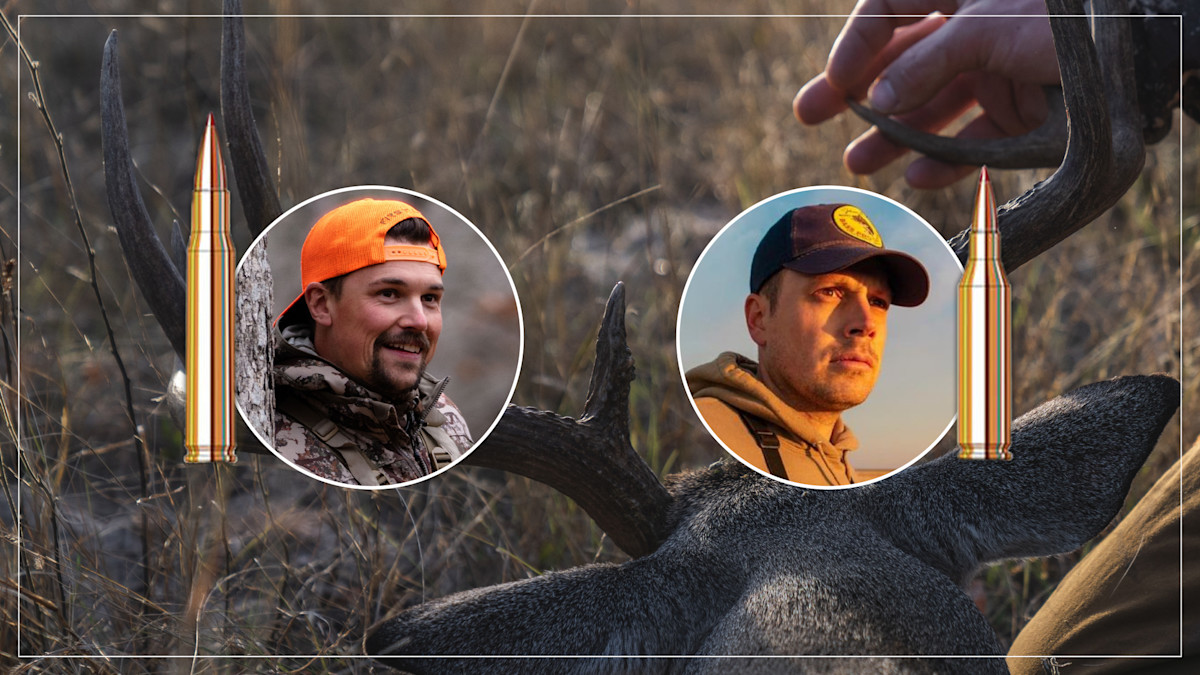
For Whitetail Week this year, we’re picking the best whitetail cartridge… ever. And by “we,” we mean “you.” Vote for your favorite cartridge by commenting below. We’ll tally up the votes from this championship round at 11:59 pm MT on Sunday, October 8. The cartridge with the most votes will be declared the Greatest Whitetail Cartridge of All Time.
This is it.
Tyler’s .243 Win. made a Cinderella run through two rounds of competition, beating out the more powerful 6.5 Creedmoor and the more legendary .30-30 Win.
Meanwhile, Mark’s .30-06 Springfield did what you’d expect from the cartridge Frank C. Barnes called, “the standard by which all other big game cartridges have been measured.” It benefited from a bye in the first round and cruised to an easy victory over Spencer’s .308 Win in the second.
Now, Tyler’s .243 Win. and Mark’s .30-06 are facing off in the championship matchup, and it’s a classic Caliber Battle conundrum: Do you want a powerful cartridge that’s a pain to shoot or an easy-shooting cartridge that doesn’t offer as much energy?
If you know already, comment below to cast your vote. If you need more info, keep reading.

The Case for Mark’s .30-06 Springfield
This is a simple argument to make. While the .30-06 and .243 achieve roughly the same muzzle velocity (about 3,000 fps), the .30-06 can do it with bullets that weigh almost twice as much.
These 165-grain .30-06 rounds, for example, exit the barrel at 2,950 feet-per-second (fps) while these 90-grain .243 pills clock in around 3,100 fps. This gives the .30-06 over 50% more kinetic energy than the .243: 3,188 ft.-lbs. versus 1,939 ft.-lbs. Those benefits don’t disappear at longer ranges. At 500 yards, a .30-06 bullet is still producing 1,600 ft.-lbs. of energy, almost double the .243’s 966 ft.-lbs.
How does more kinetic energy help you take down a whitetail? “Knockdown power” is thrown around a lot, and its importance is probably overstated. But in this matchup, it’s definitely a factor. Shooting a deer with a .30-06 gives you a better chance of dropping it in its tracks. If it does run, it will probably run a shorter distance and the blood trail will be better.
That was one of the most common critiques of the .243 in the last round of the tournament. Some of you reported seeing deer shot with a .243 and run off, never to be seen again. While shot placement is always more important than bullet energy, a dead deer in the next county won’t do you much good if you can’t track it. The much more powerful .30-06 will inflict a wider wound cavity (both temporary and permanent), and give you a better chance at venison recovery.
Plus, you aren’t sacrificing ammo and rifle cost and availability with the .30-06. As one of you said in the last round, “You can find .30-06 shells in the seat cracks of any truck at any junk yard in America.”
Easy to find, powerful, and deadly–at the end of the day, there’s not much to dislike about the .30-06 Springfield.
The Case for Tyler’s .243 Win.
This argument is also easy to make: do you want a sore shoulder or don’t you? The .30-06’s power advantage comes at a serious cost. Namely, almost twice as much recoil energy. The .243 hits with about 11 ft.-lbs. of recoil while the .30-06 delivers upwards of 20 ft.-lbs. Felt recoil changes depending on rifle weight and powder charge, but there’s a reason the .243 is a common rifle for first-time deer hunters.
How does less recoil help you take down a whitetail? For most people, softer-shooting rifles are easier to shoot accurately. Recoil is painful, and the anticipation of that pain can cause flinching. A last-second flinch is enough to pull a shot off target, and not even the .30-06 can turn a missed shot into a quick, clean kill.
And while the .243 can’t compete with the .30-06 from an energy perspective, it does mirror the .30-06’s trajectory out to most whitetail hunting distances. Using the examples mentioned above, the .243 drops about two inches less at 200, 300, and 400 yards. At 500 yards, the .243 drops about 35 inches while the .30-06 has dropped about 40 inches. You won’t hit the deer with as much power, but you have just as good a chance at hitting it in the vitals–which is more important than bullet energy, anyway.
Trajectory changes depending on bullet construction, and you’ll have an easier time finding high-BC bullets for the .30-06 than the .243. But all else being equal, the .243 is moving fast enough to maintain a flatter trajectory than its larger competition.
Combine that flat trajectory with a soft-shooting rifle, and you’ve got yourself a setup that can bring down a deer in most whitetail hunting scenarios. If the .243 has that capability, there’s no need to step up to the .30-06.
So, who you got? Comment below to cast your vote. If you want to explain your reasoning, feel free. But you don’t have to. The cartridge that gets the most votes by 11:59 pm MT on Sunday, October 8, will be declared the Champion.
Click here to check out all the kickass deals happening right now for Whitetail Week.



